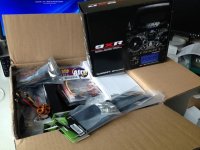Nice man!
But you might want to get some bigger batteries eventually, I have been using 8000mah 3s, 30c, works really well...
So now, what you can do
-Get out flight controller,
-Install Arduino-
-Open up arduino, Plug in Multiwii pro board,
-make sure windows has installed the board, check device manager
-Select Arduino Mega 2560- under tools tab i think in arduino
-Download multiwii firmware - https://code.google.com/p/multiwii/downloads/list
-Clear EEPROM, wait for it to upload.. ( check youtube) via arduino program, Clear eeprom is a example sketch
-Power cycle board.
-Open up the Multiwii firmware, You should see multiple tabs in arduino, select config.h
Run through all the Code, define what you need
Your board is this one #define FFIMUv2 Multiwii pro red from hobbyking, gps inc
GPS is on serial port 2, and the baud rate is 57600 ( check in code to set serial 0 1 3 to 115200 baud rate and 2 as 57600)
And your gps is configured like this in the config.h, if it does not work, switch RX and TX running from gps to FC..
/**************************************************************************************/
/*********************** GPS **************************/
/**************************************************************************************/
//#define GPS_SIMULATOR
/* GPS using a SERIAL port
if enabled, define here the Arduino Serial port number and the UART speed
note: only the RX PIN is used in case of NMEA mode, the GPS is not configured by multiwii
in NMEA mode the GPS must be configured to output GGA and RMC NMEA sentences (which is generally the default conf for most GPS devices)
at least 5Hz update rate. uncomment the first line to select the GPS serial port of the arduino */
#define GPS_SERIAL 2 // should be 2 for flyduino v2. It's the serial port number on arduino MEGA
//#define GPS_PROMINI_SERIAL // Will Autosense if GPS is connected when ardu boots.
// avoid using 115200 baud because with 16MHz arduino the 115200 baudrate have more than 2% speed error (57600 have 0.8% error)
#define GPS_BAUD 57600
/* GPS protocol
NMEA - Standard NMEA protocol GGA, GSA and RMC sentences are needed
UBLOX - U-Blox binary protocol, use the ublox config file (u-blox-config.ublox.txt) from the source tree
MTK_BINARY16 and MTK_BINARY19 - MTK3329 chipset based GPS with DIYDrones binary firmware (v1.6 or v1.9)
With UBLOX and MTK_BINARY you don't have to use GPS_FILTERING in multiwii code !!! */
#define NMEA
//#define UBLOX
//#define MTK_BINARY16
//#define MTK_BINARY19
#define INIT_MTK_GPS // initialize MTK GPS for using selected speed, 5Hz update rate and GGA & RMC sentence or binary settings



what mode is the transmitter ? Throttle on left or right ?
